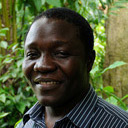Deforestation in Central Africa’s Congo Basin is lower than the average rate across Africa — but that is not likely to hold true for long, according to two recent papers that enable a better understanding of past trends while looking to the future.
One of the papers explains the history of deforestation trends in the Congo Basin in comparison with other parts of the African continent and the world. In State and evolution of the African rainforests between 1990 and 2010, Mayaux et al. observed that the Congo Basin hosts 90 percent of the continent’s rainforest and contributes to half of annual deforestation of Africa’s tropical forests. But the annual deforestation rate in the Congo Basin is three times and nine times lower, respectively, than that of West Africa and Madagascar, Africa’s two other main tropical forest regions.
On a historical basis, Mayaux et al. observed that the annual net deforestation rate in the Congo Basin during 2000-2010 was 0.1 percent, against 0.16 percent in 1990-2000. This reduction is low, compared with the average net annual deforestation throughout Africa, which fell by half — 0.28 percent to 0.14 percent — over the same periods.
According to Mayaux et al., the deforestation rate may be associated with low population density and with the nature of the drivers of deforestation. Mayaux et al. highlighted deforestation associated with fuel wood extraction in peri-urban areas and with population increase, shifting cultivation, and logging in rural areas. With the low population density and the nature of exploitation, the value chain of agriculture and logging in the region is not yet associated with major deforestation — but it is uncertain whether this trend can be maintained.
What will the future of forests look like in the Congo Basin?
In the second report, The World Bank found four key reasons why deforestation in Central Africa is comparatively low: Road transport networks are sparse and poorly maintained; abundant mining resources remain largely untapped; wood-based energy is the largest share of the energy portfolio, but per capita charcoal consumption is low; and the agricultural sector has been neglected and underfunded.
But things are changing in the region, due in part to the global market. According to the Bank, the Congo Basin’s population is set to double between 2000 and 2030, when 170 million people will need food, energy, shelter and employment in the region. Moreover, the countries of this region are likely to enter a new development cycle with more exposure to the international market, with global economic factors driving more investment in the Congo Basin.
Taken together, the two publications indicate that the future of the region’s forests is not so bright. While each of the sectors studied by the Bank had a potential impact on the forest, road infrastructure seems to be the one most associated with deforestation. But, according to Mayaux et al., “a complete ban on road building would significantly reduce the development prospects of many remote areas.” This is where planning and law enforcement may play a role in avoiding deforestation and degradation, especially as urbanization drives greater demand for wood energy, and as regional stability makes mining more attractive — and more profitable.
According to the Bank, changes in the agricultural sector will be associated with (i) national/regional/international demand of agricultural products, (ii) the suitability/availability/accessibility of land, (iii) the potential to increase productivity and (iv) water availability, as other parts of the world experience water scarcity, etc.
The Bank sees REDD+ as having the potential to provide resources to help the countries of the Congo Basin protect their forests, among a list of “no-regret” possibilities for measures to ensure a brighter future for the forest. Increased deforestation, meanwhile, will have a negative impact on services provided by the Congo Basin, such as biodiversity conservation, water cycling, and climate change mitigation/adaptation.
We want you to share Forests News content, which is licensed under Creative Commons Attribution-NonCommercial-ShareAlike 4.0 International (CC BY-NC-SA 4.0). This means you are free to redistribute our material for non-commercial purposes. All we ask is that you give Forests News appropriate credit and link to the original Forests News content, indicate if changes were made, and distribute your contributions under the same Creative Commons license. You must notify Forests News if you repost, reprint or reuse our materials by contacting forestsnews@cifor-icraf.org.














